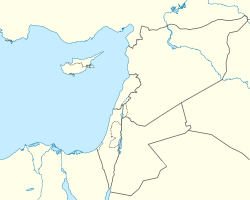Background
First Crusade
After the capture of Antioch in June 1098 and the destruction of Ma'arrat al-Numan on 13 January 1099, the Syrian emirs were terrified of the advancing Crusaders and quickly handed over their cities to them. On 14 January Sultan ibn Munqidh, emir of Shaizar, dispatched an embassy to Raymond IV of Toulouse, one of the leaders of the crusade, to offer provisions for men and horses, as well as guides to Jerusalem. In February, the emir of Homs, Janah ad-Dawla, who had fought bravely at the siege of Antioch, offered horses to Raymond. The qadi of Tripoli, Jalal al-Mulk, from the Banu Ammar, sent rich gifts and invited the Franks to send an embassy to his city. The ambassadors marvelled at the splendors of the city, and an alliance was concluded. The crusades moved on to Arqa, which they besieged from 14 February to 13 May, before continuing south to Jerusalem; they did not attack Tripoli or any other possessions of the Banu Ammar.
Raymond returns to Tripoli
The 1099 siege of Jerusalem was a success and led to the foundation of the Kingdom of Jerusalem. Most Crusaders returned home afterwards; a second crusade set out in 1101, encouraged by the success of the First Crusade, but the army was mostly annihilated by the Seljuk Turks in Anatolia. Raymond participated in this crusade as well and returned to Syria after escaping from his defeat at the hands of Kilij Arslan I in Anatolia. He had with him 300 men. Fakhr al-Mulk, qadi of Tripoli, was not as accommodating to Raymond as his predecessor had been and called for assistance from Shams al-Muluk Duqaq, ruler of Damascus and Homs. However, the troops from Damascus and Homs defected once they reached Tripoli, and Fakhr al-Mulk was defeated at the beginning of April, losing 7,000 men. Raymond could not take Tripoli but captured Tortosa, which became the base of future operations against Tripoli.
Siege
In 1102 with the aid of Byzantine engineers, Raymond constructed Mons Peregrinus—"Pilgrim's mountain" or "Qalaat Saint-Gilles" ("fortress of Saint-Gilles")—in order to block Tripoli's access inland. With the Genoese Hugh Embriaco, Raymond also seized Gibelet. After the Battle of Harran on 7 May 1104, Fakhr al-Mulk asked Sokman, the former Ortoqid governor of Jerusalem, to intervene; Sokman marched into Syria but was forced to return home.
Fakhr al-Mulk attacked Mons Peregrinus in September 1104, killing many of the Franks and burning down one wing of the fortress. Raymond was badly wounded and died five months later in February 1105. He was replaced by his nephew William II Jordan, Count of Cerdanya. On his deathbed, Raymond had reached an agreement with Fakhr al-Mulk: if he would stop attacking the fortress, the Crusaders would stop impeding Tripolitanian trade and merchandise. Fakhr al-Mulk accepted.
In 1108, it became more difficult to bring food to the besieged by land. Many citizens sought to flee to Homs, Tyre, and Damascus. The nobles of the city, who had betrayed the city to the Franks by showing them how it was being resupplied with food, were executed in the Crusader camp. Fakhr al-Mulk, waiting for help from the Seljuk Sultan Mehmed I, went to Baghdad in March with 500 troops and many gifts. He passed through Damascus, governed by Toghtegin after the death of Duqaq, and was welcomed with open arms. In Baghdad, the sultan received him with great spectacle but had no time for Tripoli while there was a succession dispute in Mosul. Fakhr al-Mulk returned to Damascus in August, where he learned Tripoli had been handed over to Sharaf ad-Dawla ibn Abi al-Tayyib, wali of al-Afdal Shahanshah, vizier of Egypt, by the nobles who were tired of waiting for him to return.
In 1109 the Crusaders gathered in force outside Tripoli, led by Baldwin I of Jerusalem, Baldwin II of Edessa, Tancred, regent of Antioch, William II Jordan, and Raymond IV's eldest son Bertrand of Toulouse, who had recently arrived with fresh Genoan, Pisan and Provençal troops. Tripoli waited in vain for reinforcements from Egypt.
A compromise decided in the course of a dispute beneath the walls of the city, and arbitrated by Baldwin of Jerusalem, allowed the city to be captured: the County of Tripoli would be divided between the two claimants, William II Jordan as a vassal of the Principality of Antioch, and Bertrand as a vassal of Jerusalem.
On 12 July the city was sacked by the Crusaders. One hundred thousand volumes of the Dar-em-Ilm library were deemed "impious" and burned. The Egyptian fleet arrived eight hours too late. Many of the inhabitants were enslaved, the others were deprived of their possessions and expelled. Bertrand had William II Jordan assassinated in 1110 and claimed two-thirds of the city for himself, with the other third given to the Genoans. Thus Tripoli became a Crusader state; the rest of the Mediterranean coast had already fallen to the Crusaders or would pass to them within the next few years, with the capture of Sidon in 1110 and Tyre in 1124 during the Venetian Crusade.
This page is based on this
Wikipedia article Text is available under the
CC BY-SA 4.0 license; additional terms may apply.
Images, videos and audio are available under their respective licenses.


